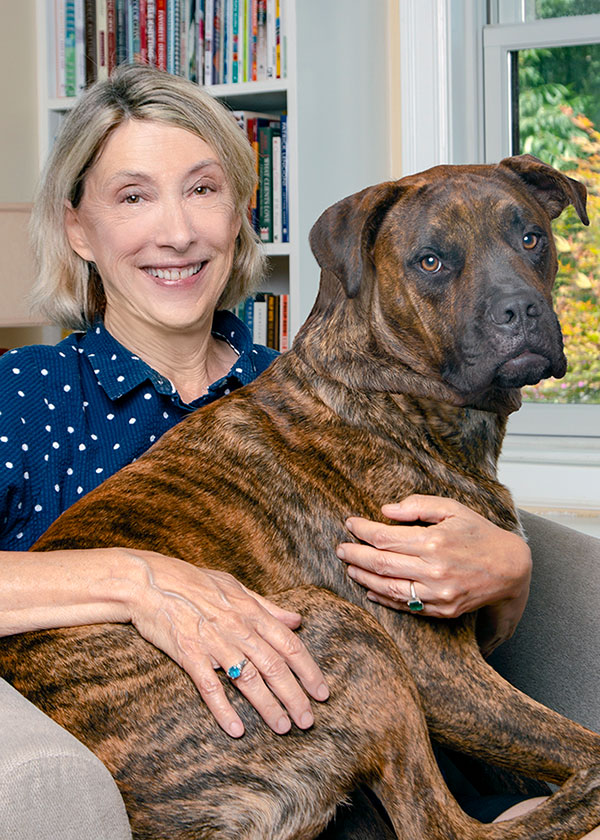For Putnam Service Dogs, animal welfare is absolutely essential when it comes to training a service dog. In training rescue pups as service dogs for people with disabilities other than blindness and veterans with PTSD, we’re committed to the humane treatment of our dogs. We champion the nurturing bond between dogs and the people they serve, ensuring long-lasting, loving relationships that benefit both the service dog and their recipient.
What are the basics of service dog welfare, and how do we incorporate them into everything we do? From choosing a puppy to making a match and even to the service dog’s retirement, Putnam Service Dogs takes humaneness seriously throughout the dogs’ lives.
How Animal Welfare Impacts Puppy Choice
Almost every service dog that Putnam Service Dogs trains comes from a local shelter or rescue, and while we know very little about these dogs’ pasts in most cases, we look for a specific temperament. Temperament is established very early on – in people and in dogs. Though we are both products of our environments to a degree, our temperaments ultimately determine how we will react and respond to stimuli. By carefully choosing dogs who tend to respond to specific situations in certain ways, we’re able to champion their abilities, rather than force them to do things they don’t want to do or aren’t naturally inclined to do. We can’t train a timid dog to confidently go to a new, busy venue, medical setting, etc.
Ideal Service Dog Temperament
Putnam Service Dogs utilizes a modified version of the Volhard Temperament Testing model to seek highly specific characteristics in our future service dogs. We look for dogs who are:
- Sociable: Sociability is vital when it comes to service dog welfare and making a good match with a recipient. We choose dogs who come when they are called, who want to interact with people, and who follow when someone walks away.
- Confident: Confidence allows dogs to express curiosity when someone drops something or when they are shown something new. It allows dogs to retrieve dropped items and bring them back, as well. This is not merely instinctual in service dogs. We look for puppies who are interested in cooperating and who enjoy working closely with humans.
- Sensitive (or Non-Sensitive): Sensitivity is a broad category. For example, we do not choose dogs who are touch sensitive simply because they will need to wear vests and experience some jostling. On the other hand, if we plan to train a dog for someone who is hearing-impaired, we look for a dog who is sensitive to sound.
- Focus: Focus is another critical characteristic for service dogs. Dogs should not react or respond to everything in their peripheral vision, but should instead remain focused on their raiser, trainer, or person they’re assisting.
How Putnam Service Dogs Chooses Service Animals
When we go into a shelter, we do not have a specific attribute in mind. We have trained dogs for a wide range of conditions and disabilities, so while we consider the needs of our clientele, temperament is the primary concern. Most of our dogs are trained for mobility issues, so we look for animals who are easy to handle, able to retrieve well, and happy to go out in public to all places we take them, and will work with people. We even think about the size and strength of the dogs, their wagging tails, and whether or not they are capable of knocking someone over. Our candidates for Hearing Alert dogs can be any size. Responsiveness to sounds is more key than their size, unlike mobility assistance dogs.
What Does It Mean to Treat Service Dogs Humanely?
Putnam Service Dogs usually has eight to twelve dogs in various stages of training in a very small, very cozy homelike environment. We can house four dogs at our Center, and volunteer puppy raisers house the rest. Part of animal welfare, especially for service dogs, is making sure that each one gets plenty of training and companionship from a very early age. Later, when they are placed with their recipients, humaneness is in the care they receive.
What About the Welfare of Dogs with Demanding Jobs?
Service dogs have incredibly demanding jobs because they’re on alert 24/7 to assist their person with disabilities. If the dog is napping, and their person drops their phone, the dog has to be willing to get up to retrieve it for their person. Putnam Service Dogs chooses animals who display focus and desire early on, and we gradually help them develop the stamina and work ethic they need. The humane treatment of dogs – especially service dogs – is all about love and care. They bond with everyone they encounter, including volunteer raisers when they are puppies, our trainer, and eventually their recipients. More than anything else, service dogs need to do their jobs because they want to – not because we want them to or because someone forces them to.
According to the Animal Humane Society, there are five freedoms of animal welfare, and Putnam Service Dogs takes these very seriously.
- Freedom from Hunger and Thirst – Providing dogs with access to fresh water and a healthy diet that is specific to the animals’ needs is paramount to animal welfare.
- Freedom from Discomfort – Dogs deserve appropriate, safe environments, shelters, and play areas.
- Freedom from Pain, Injury, or Disease – Regular veterinary care, vaccinations, monitoring, and medications as needed will keep dogs healthy and happy.
- Freedom to Express Normal Behavior – All dogs need to be themselves, and it is up to humans to make room for that expression. This includes barking, playing, running, and jumping as is appropriate for the dog’s breed and role.
- Freedom from Fear and Distress – Service dog welfare includes ensuring that dogs live in conditions and receive treatment that eliminates mental suffering. Its crucial that service dogs love and trust people.
Avoiding Burnout and Stress with Dog Freedom
Burnout and stress can occur in all animals, and this is even true for service dogs. We train from young puppyhood through early adulthood, and during these two years, the main focus is obedience, socialization, and house manners. At 18 months- two years old, most dogs are ready to start learning their jobs. It’s important to remember the importance of dog freedom, too.
A service dog’s training should never take over his or her life. There are plenty of meaningful opportunities to train, but puppies are puppies, and adolescents are adolescents. Healthy, happy dogs are given the opportunity to be healthy, happy youngsters. For example, if one of our dogs wants to take a walk, we use that opportunity to train them on proper walking behavior instead of having them sit.
All dogs – especially service dogs – need time to play. They need the opportunity to just be dogs and enjoy their environment. Putnam Service Dogs knows that observing a dog at play is an incredible way to determine his or her emotional state. Fearful, sad, and overworked dogs won’t feel much like playing. Happy dogs are wiggly and excited for their play. We emphasize patience in our training, and we believe allowing ample dog freedom and play (in a controlled and safe environment) is equally as important as training – especially for puppies.
Examples of Humane Treatment of Dogs who are Disobedient
Many of the things that dog owners consider disobedience isn’t really disobedience. Rather, it’s a lack of proper training in that particular area. Most dogs who bond with humans want to make their humans happy and do the right thing. Raisers, trainers, and recipients are responsible for helping dogs do the right thing.
If a dog appears to disobey, we have to ask ourselves why:
- Did the dog know what we wanted him or her to do?
- Did we provide the correct external cue?
- Have we allowed enough rest or play?
- Did we motivate him or her in the form of a food reward, affection, or free time to sniff around?
Part of facilitating service dog welfare involves always remembering that the dogs need to know we are on their side. To do that, we have to give them what they want just as much as they give us and their recipients what we need.
What Does Service Dog Retirement Look Like?
The loving bond between a human and service dog is so very strong that people with disabilities often know in their hearts when it is time for their canine companions to stop working. There is no specific number of years that a service dog can work; it depends on their job, size, health, and other factors. Despite all the training in the world, dogs are like people. Their attitudes, needs, and abilities change as they grow older. It’s up to the recipient to take a “temperature reading” if you will, and reach out when concerns or questions arise.
How Putnam Service Dogs Prioritizes Humaneness
Who we place a retired service dog with varies with each retiring dog. We consider their preferences, needs, personality, health issues, and energy level when we seek their home as a now pet dog. It may be best for the recipient to keep them if they won’t interfere with a new service dog the recipient may get. We receive new applications to adopt our release dogs every month. Many dog lovers seek a nice dog, and a well trained dog, which a service dog is. We carefully vet each retirement placement – talking extensively to the applicant(s), and screening references that know them well. Ultimately, the dog shows us if they naturally like their new person.
At Putnam Service Dogs we put the welfare of our animals above everything else. Our specific criteria for choosing, raising, and training puppies helps, but our passion for helping people and dogs form loving, long-lasting bonds makes us truly special.
Are you as passionate as we are about service dog welfare? Volunteer to raise a service dog puppy and change lives – not only for the puppy, but also for an individual with a disability other than blindness, or a veteran with PTSD. If you prefer, please support our cause with your donation.
Sources
- Volhard Dog Nutrition, Temperament Testing: Volhard’s Guide to Predicting Canine Personalities
- Animal Humane Society, The Five Freedoms for Animals






